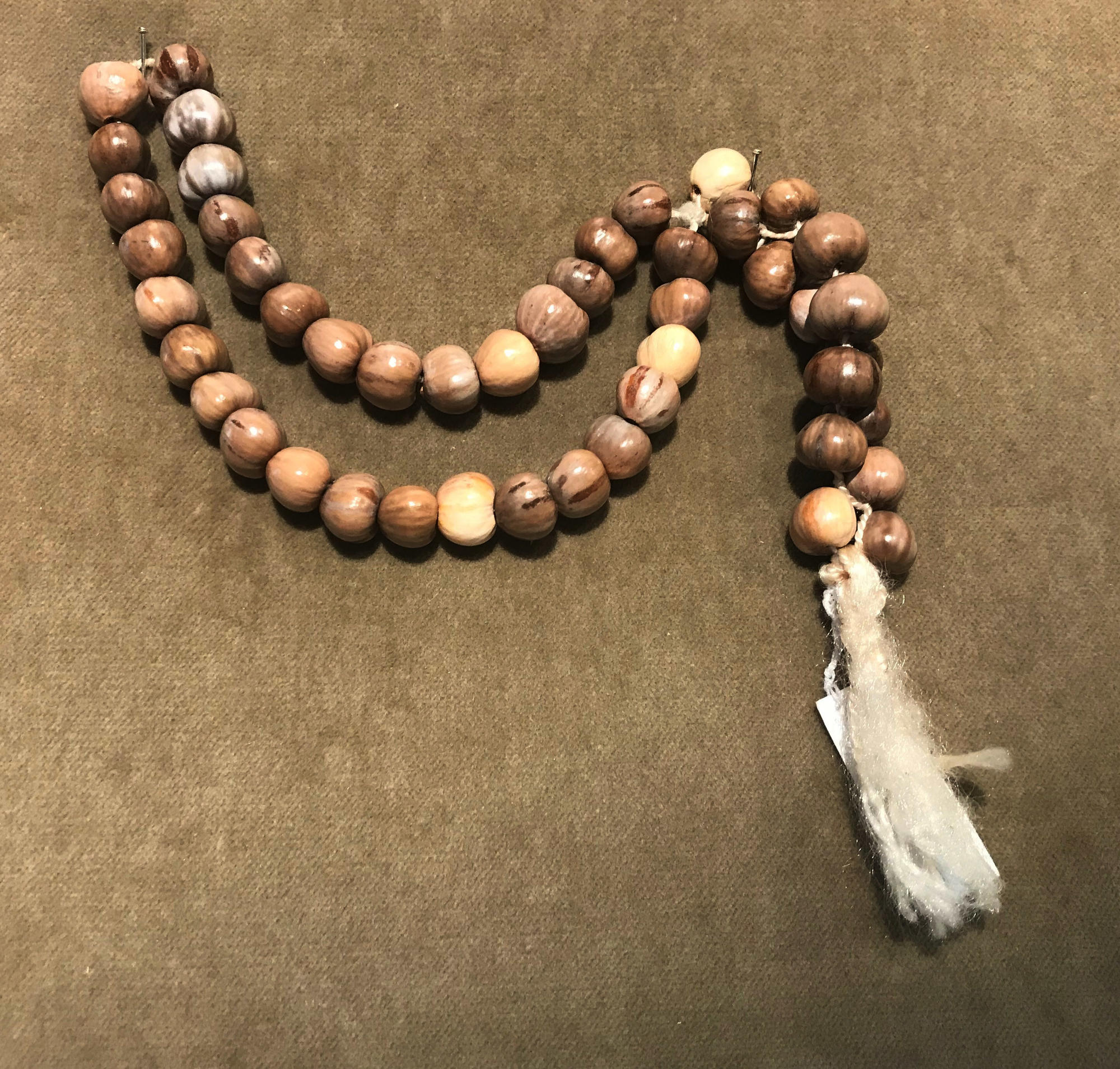According to the experts, the wooden beads were made in the early 20th century. Big pendants of light-coloured wood on a strong thread are put into a loop with one slightly bigger elongated pendant decorated with a long tassel.
An interesting fact: traditional Moslem beads have either 99 pendants (subhah meaning ‘light’ in Arabic) or 33 pendants (misbah meaning ‘torch’, ‘lamp’, and ‘vessel for light’). However, the ones presented here have 44 pendants (if we do not count the elongated one). Hence, they are in line with the main principle of Moslem beads: the number of pendants needs to be multiple of eleven. Eleven pendants (tasbih meaning ‘to repeat’ or ‘to remember’) symbolize the number of times Allah is mentioned by name and 11 parts of the prayer, while as 99 — the number of Allah’s names.
Christians also use beads for their religious rites, but the number of pendants is multiple of 10 – in accordance with the number of commandments.
In both cases, the beads play one and same ritual role, pendants on a thread constitute a part of the praying ritual. The beads help control the number of praises to Allah (zikrs) and of pronounced prayers; they set the pace of reading out a prayer and the state of mind for the praying person; they create the atmosphere for easy dissociation from the mundane outside world and concentration of performing the namaz.
There are other useful things, which are not directly related to Islam or to any religion in general. Shuffling of pendants with one’s fingertips helps to remove tension and relax, results in peace, calm and appeasement. The beads easily remove muscular strain; help to focus on pleasant thoughts or on important task. It is also easier to calm oneself after a tempest of anger. The explanation is in the connection between the nerve terminals on the fingertips and the nerve centres in the brain. The tactile sensations from touching smooth pendants have favourable effects on the psyche and on the person’s state of health in general.
The pendants for the beads may be from different materials: semi-precious stones (e.g., amber), ivory, glass and wood. The most often used types of wood are oak, ash, as well as valuable exotic types like ebony, for example.
It is worth emphasizing that Moslem beads are different from the Christian prayer ropes by their impeccable shape and aesthetics. In Islam, to possess beautiful beads means to have higher status, the religion assumes that a person telling his beads attracts attention and draws stares, so every detail of such person needs to give rise to admiration.
The beads are still relevant in the modern world as a faithful companion of a serious spiritual personality. They serve to the believers of various religions: Christianity, Buddhism and Islam. They may have different number of pendants, differ in colour and quality of material but their ritual function remains unchanged.
An interesting fact: traditional Moslem beads have either 99 pendants (subhah meaning ‘light’ in Arabic) or 33 pendants (misbah meaning ‘torch’, ‘lamp’, and ‘vessel for light’). However, the ones presented here have 44 pendants (if we do not count the elongated one). Hence, they are in line with the main principle of Moslem beads: the number of pendants needs to be multiple of eleven. Eleven pendants (tasbih meaning ‘to repeat’ or ‘to remember’) symbolize the number of times Allah is mentioned by name and 11 parts of the prayer, while as 99 — the number of Allah’s names.
Christians also use beads for their religious rites, but the number of pendants is multiple of 10 – in accordance with the number of commandments.
In both cases, the beads play one and same ritual role, pendants on a thread constitute a part of the praying ritual. The beads help control the number of praises to Allah (zikrs) and of pronounced prayers; they set the pace of reading out a prayer and the state of mind for the praying person; they create the atmosphere for easy dissociation from the mundane outside world and concentration of performing the namaz.
There are other useful things, which are not directly related to Islam or to any religion in general. Shuffling of pendants with one’s fingertips helps to remove tension and relax, results in peace, calm and appeasement. The beads easily remove muscular strain; help to focus on pleasant thoughts or on important task. It is also easier to calm oneself after a tempest of anger. The explanation is in the connection between the nerve terminals on the fingertips and the nerve centres in the brain. The tactile sensations from touching smooth pendants have favourable effects on the psyche and on the person’s state of health in general.
The pendants for the beads may be from different materials: semi-precious stones (e.g., amber), ivory, glass and wood. The most often used types of wood are oak, ash, as well as valuable exotic types like ebony, for example.
It is worth emphasizing that Moslem beads are different from the Christian prayer ropes by their impeccable shape and aesthetics. In Islam, to possess beautiful beads means to have higher status, the religion assumes that a person telling his beads attracts attention and draws stares, so every detail of such person needs to give rise to admiration.
The beads are still relevant in the modern world as a faithful companion of a serious spiritual personality. They serve to the believers of various religions: Christianity, Buddhism and Islam. They may have different number of pendants, differ in colour and quality of material but their ritual function remains unchanged.



